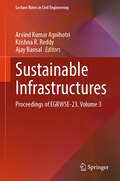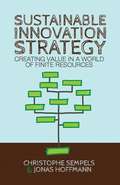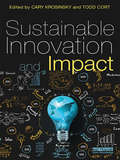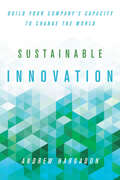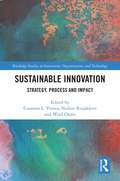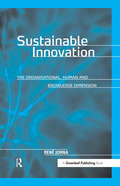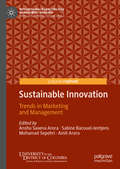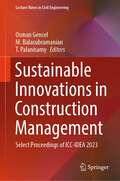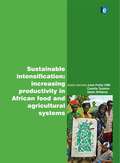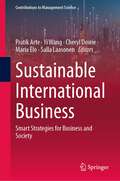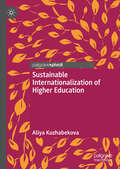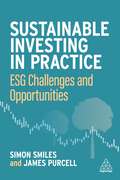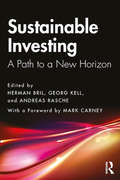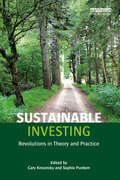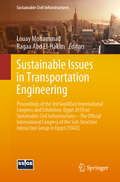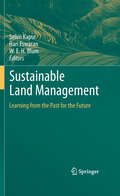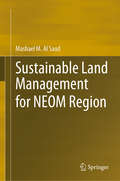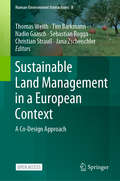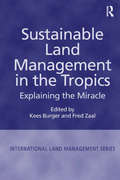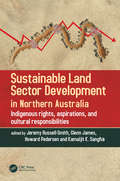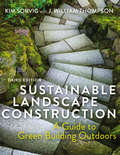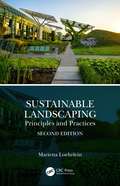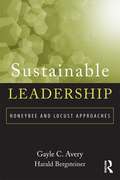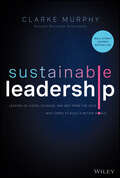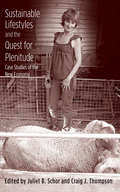- Table View
- List View
Sustainable Infrastructures: Proceedings of EGRWSE-23, Volume 3 (Lecture Notes in Civil Engineering #355)
by Krishna R. Reddy Arvind Kumar Agnihotri Ajay BansalThis book contains peer-reviewed and selected papers presented during the International Conference on Environmental Geotechnology, Recycled Waste Materials and Sustainable Engineering (EGRWSE) 2023, held at NIT Jalandhar. It discusses the recent innovations, trends, concerns, practical challenges encountered, and the solutions adopted in waste management and engineering, geotechnical and geoenvironmental engineering, infrastructure engineering and sustainable engineering. This book can serve as a useful resource for researchers, educators, policymakers, and professionals working in the field of civil engineering, chemical engineering, environmental sciences, and public policy.
Sustainable Innovation Strategy
by Jonas Hoffmann Christophe SempelsExamining the links between sustainable development, innovation strategy and the business model, this thought-provoking and timely book uses insightful case studies from mature and developing markets to demonstrate how sustainability needs to be at the core of every organization's strategy and innovation.
Sustainable Innovation and Impact
by Cary Krosinsky Todd CortFollowing the Brexit and Trump election cycles, consistent, long-term policy solutions to environmental and other societal challenges are becoming increasingly difficult to achieve. Stepping into this breach is a clear opportunity for innovation by public and privately held companies, as well as the increasingly significant role of investment and consumption. Sustainable Innovation and Impact provides a roadmap of the many critical pathways of positive change emerging to achieve modern day societal success, including rapidly evolving corporate and investment innovation and impact strategy considerations. Exploring innovation around the future of energy, electricity and related technologies, as well as transportation and buildings efficiency, Krosinsky and Cort consider ideas framed around the circular economy, operational and supply chain strategies and the global economy. Drawing together a diverse range of contributors and case studies, this book will be of great relevance to students, scholars and professionals with an interest in innovation, economics and sustainability more broadly.
Sustainable Innovation: Build Your Company's Capacity to Change the World
by Andrew HargadonIf we can carry in our pockets more computing power than the Apollo program needed to put a man on the moon, why can't we solve problems like climate change, famine, or poverty? The answer lies, in part, in the distinctive challenges of creating innovations that address today's pressing environmental and social problems. In this groundbreaking book, Andrew Hargadon shows why sustainable innovation--the development of financially viable products that support a healthy environment and communities--is so difficult when compared to creating the next internet ventures or mobile apps that disregard these criteria. While other books treat innovation across sectors equally, Hargadon argues that most effective innovation strategies hinge on attention to the context in which they are pursued. Instead of relying on a stale set of "best practices," executives must craft their own strategies based on the particulars of their industries and markets. But, there are some rules of the road that foster a triple bottom line; this book provides a research-based framework that outlines the critical capabilities necessary to drive sustainable innovation: a long-term commitment, nexus work, science and policy expertise, recombinant innovation, and robust design. Sustainable Innovation draws on a wide range of historical and contemporary examples to show business readers and their companies how to stand on the shoulders of successful pioneers.
Sustainable Innovation: Strategy, Process and Impact (Routledge Studies in Innovation, Organizations and Technology)
by Cosmina L. Voinea Nadine Roijakkers Ward OomsThe most important theme of the discourse on sustainable development and sustainability challenges concerns the relationship between innovation and sustainability. This book represents a realistic critical overview of the state of affairs of sustainable innovations, offering an accessible and comprehensive diagnostic point of reference for both the academic and practitioner worlds. In order for sustainable innovation to truly become mainstream practice in business it is necessary to find out how organizations can strategically and efficiently accommodate sustainability and innovation in such a manner that they accomplish value capturing (for firms, stakeholders, and for society), not merely creating a return on the social responsibility agenda. Addressing this challenge, the book draws together research from a range of perspectives in order to understand the potential shifts and barriers, benefits, and outcomes from all angles: inception, strategic process, and impact for companies and society. The book also delivers insights of (open) innovation in public sector organizations, which is not so much a process of invention as it is one of adoption and diffusion. It examines how the environmental pillar of the triple bottom line in private firms is often a by-product of thinking about the economic pillar, where cost reductions may be achieved through process innovation in terms of eliminating waste and reducing energy consumption. The impact of open innovation on process innovation, and sustainable process innovation in particular, is an underexplored area but is examined in this book. It also considers the role of the individual entrepreneur in bringing about sustainable innovation; entrepreneurs, their small- and medium-sized enterprises (SMEs), as well as the innovation ecosystems they build play a significant role in generating sustainable innovations where these smaller organizations are much more flexible than large organizations in targeting societal needs and challenges. The readership will incorporate PhD students and postgraduate researchers, as well as practitioners from organizational advisory fields.
Sustainable Innovation: The Organisational, Human and Knowledge Dimension
by René JornaHOW SUSTAINABLE IS INNOVATION? Problematically, most contemporary patterns of innovation in human social systems and organisations are not sustainable. This prevents people from learning effectively, from recognising and solving their problems, and from operating in sustainable ways. It is arguably why societies, businesses and industries around the world are so unsustainable. Sustainable innovation is a pattern of social learning and problem-solving that is, itself, sustainable. The sustainability of innovation, moreover, is linked to the sustainability of its outcomes, which manifest themselves in what people produce and do in the world. Sustainable innovation, then, is a necessary precondition for sustainability in how societies and organisations function – the ways they organise, the products and services they make, the energy and resources they use, and the wastes they produce. As challenges such as demographic pressures, ethnic tensions, terrorism, global poverty, pandemics and abrupt climate change force their way into mainstream politics and business, so we see growing interest in innovation, entrepreneurial solutions and, critically, issues such as how to ensure successful solutions replicate and scale. Sustainable Innovation aims to illustrate that shift. Instead of simply focusing on environmental and technological matters, it views and evaluates innovation-for-sustainability in terms of the human, social and management challenges and responses. It argues that a just, efficient and sustainable balancing of these elements is best achieved by the development of new knowledge, and by the evolution of better means both of embedding that emerging knowledge in organisations and institutions, and of managing the relevant flows of information, knowledge and wisdom. The book stresses that claims that a particular product, production process or service are sustainable usually assume that an appropriate balance has been achieved between people, planet and profit. However, calculating the sustainability of such things, let alone of complex systems such as enterprises or economies, can be impossible. Instead of "sustainability", the book favours the use of terms such as "making sustainable", emphasising that in dynamic operating environments organisational processes are changing constantly, whether or not they are under effective strategic control by management. Innovation, too, is dynamic by definition. Sustainable Innovation argues that there must be a constant focus on the triple bottom line of economic, social and environmental value creation during the innovation process. Sustainable innovation is a new challenge for organisations. It is a process that should permeate the whole organisation, in terms of its members, its tasks, its coordination mechanisms and its procedures. Waste or pollution should not be seen as the reason for further intervention downstream, but as an end-of-the-pipe effect, which could be organisationally cured upstream. Developed from the Dutch research programme "Knowledge Creation for Sustainable Innovation", this book presents empirical research and cases to develop a theory of sustainable innovation that is based on management of knowledge, knowledge and cognition and innovation approaches. Sustainable Innovation suggests that knowledge and innovation will be the key drivers of social and corporate sustainability in the years ahead. It will be essential reading for managers and researchers in areas such as sustainability, innovation, knowledge management and organisational learning.
Sustainable Innovation: Trends in Marketing and Management (International Marketing and Management Research)
by Anshu Saxena Arora Sabine Bacouel-Jentjens Mohamad Sepehri Amit AroraIn today’s ever-changing global world, there is a permanent need for anticipating new and evolving customer needs, resource supply constraints, and dynamically changing employee expectations. Sustainable innovation applies to products, services, and technologies as well as new business and organization models. This book provides insights into sustainable innovation trends in various marketing- and management-related fields. Authors critically investigate, amongst others, the sustainability impact of disruptive product design and innovative collaboration solutions within buyer-supplier relationships, along with innovative organizational processes to promote sustainable well-being-productivity synergy in a VUCA world. This volume is a uniquely positioned contribution of interrelated research articles on the sustainability-driven innovation needed for organizational health and future viability.
Sustainable Innovations in Construction Management: Select Proceedings of ICC-IDEA 2023 (Lecture Notes in Civil Engineering #388)
by M. Balasubramanian Osman Gencel T. PalanisamyThis book presents the select proceedings of International Conference on Civil Engineering: Innovative Development in Engineering Advances (ICC IDEA 2023). This book covers the latest research in the areas of construction engineering and management, urban planning and design, building energy conservation and green architecture, materials science and engineering, innovation in construction materials, and information technology in civil engineering. The book is useful for researchers and professionals in civil engineering.
Sustainable Intensification: Increasing Productivity in African Food and Agricultural Systems
by Camilla Toulmin Jules N. Pretty Stella WilliamsContinued population growth, rapidly changing consumption patterns and the impacts of climate change and environmental degradation are driving limited resources of food, energy, water and materials towards critical thresholds worldwide. These pressures are likely to be substantial across Africa, where countries will have to find innovative ways to boost crop and livestock production to avoid becoming more reliant on imports and food aid. Sustainable agricultural intensification - producing more output from the same area of land while reducing the negative environmental impacts - represents a solution for millions of African farmers. This volume presents the lessons learned from 40 sustainable agricultural intensification programmes in 20 countries across Africa, commissioned as part of the UK Government's Foresight project. Through detailed case studies, the authors of each chapter examine how to develop productive and sustainable agricultural systems and how to scale up these systems to reach many more millions of people in the future. Themes covered include crop improvements, agroforestry and soil conservation, conservation agriculture, integrated pest management, horticulture, livestock and fodder crops, aquaculture, and novel policies and partnerships.
Sustainable International Business: Smart Strategies for Business and Society (Contributions to Management Science)
by Yi Wang Maria Elo Pratik Arte Cheryl Dowie Salla LaasonenThis is a unique book that adopts a global approach to studying international business. It stimulates research and rethinking among scholars and practitioners to understand how businesses operate internationally into lucrative markets, and their role in sustainable business growth, glocal value creation, and economic development. It provides insights into how international firms, entrepreneurs, family businesses, and other stakeholders balance the act of value creation and conducting sustainable and ethical business. The book covers economic, social, and environmental dimensions of sustainability such as poverty alleviation through FDI and remittances, diversity and inclusion in management, and ethical governance to value creation for stakeholders and profit maximization through sustainable firm growth, entrepreneurial initiatives, and sustainable business models. It addresses capacity building and the grand challenges that international business needs to develop solutions for. The chapters offer multiple types of contributions including conceptual and theoretical works, literature reviews, and empirical (qualitative and quantitative) studies. The authors, and the topics included, provide a wide international representation and illustrate multi-layered sustainable business perspectives that cover developing, emerging, and developed country contexts as well as multiple directions of international business flows.
Sustainable Internationalization of Higher Education
by Aliya KuzhabekovaThis book analyzes the concept of sustainability as it applies to internationalization of higher education. The topic of sustainability is relatively well explored in the context of higher education. It is becoming increasingly discussed by scholarly societies in international and comparative education. However, there is still a dearth of studies on the topic within the narrow field of international and comparative education. This book presents an organizing framework to explore sustainable internationalization in a comprehensive way and offers practical insights on how sustainable internationalization can be achieved in various aspects of internationalization.
Sustainable Investing in Practice: ESG Challenges and Opportunities
by Dr Simon Smiles James PurcellThe compelling promise of progressing profits, purpose and the planet is what drives sustainable investing. Yet the field is also packed with challenges and pitfalls for the finance industry.Sustainable Investing in Practice provides a pragmatic steer for how finance professionals can navigate the realities of ESG investing so they can achieve the impact they desire. It addresses the obvious problems - a lack of common standards, opaque vocabulary, irrelevant data - that investors face. And it explains the skewed incentives and compromises that have held sustainable investing back. Yet it does not dwell on obstacles and defeat. Instead, it shows readers how to develop sustainable strategies and improve outcomes, covering critical topics such as ESG ratings, data and disclosure policies and multi-asset portfolios, while also documenting successful practices and pointing out how to modify inadequate ones. Packed full of insightful examples, analysis and interviews from expert commentators such as Paul Polman KBE, Richard Curtis OBE, and Gillian Tett, the book provides useful ideas and plans for how to take sustainable finance forward while balancing credibility and commerciality in equal measure. Written by two pioneering leaders within sustainable investing, this is a must-read for every finance professional, investor and regulator-whether they are seeking to fast track their careers, bring commercial and sustainable learning to their organization, or upgrade their understanding of this crucial but complex topic. It will also be of interest to students taking modules on sustainable finance.
Sustainable Investing: A Path to a New Horizon
by Herman BrilThis book tells the story of how the convergence between corporate sustainability and sustainable investing is now becoming a major force driving systemic market changes. The idea and practice of corporate sustainability is no longer a niche movement. Investors are increasingly paying attention to sustainability factors in their analysis and decision-making, thus reinforcing market transformation. In this book, high-level practitioners and academic thought leaders, including contributions from John Ruggie, Fiona Reynolds, Johan Rockström, and Paul Polman, explain the forces behind these developments. The contributors highlight (a) that systemic market change is influenced by various contextual factors that impact how sustainable investing is perceived and practiced; (b) that the integration of ESG factors in investment decisions is impacting markets on a large scale and hence changes practices of major market players (e.g. pension funds); and (c) that technology and the increasing datafication of sustainability act as further accelerators of such change. The book goes beyond standard economic theory approaches to sustainable investing and emphasizes that capitalism founded on more real-world (complex) economics and cooperation can strengthen ESG integration. Aimed at both investment professionals and academics, this book gives the reader access to more practitioner-relevant information and it also discusses implementation issues. The reader will gain insights into how "mainstream" financial actors relate to sustainable investing.
Sustainable Investing: Revolutions in theory and practice
by Cary Krosinsky Sophie PurdomA seminal shift has taken place in the world of investing. A clear and overarching reality has emerged which must be solved: financial considerations must factor in sustainability considerations for ongoing societal success, while sustainability issues equally need to be driven by a business case. As a result, investment practices are evolving, especially towards more positive philosophies and frameworks. Sustainable Investing brings the reader up to speed on trends playing out in each region and asset class, drawing on contributions from leading practitioners across the globe. Implications abound for financial professionals and other interested investors, as well as corporations seeking to understand future investment trends that will affect their shareholders’ thinking. Policymakers and other stakeholders also need to be aware of what is happening in order to understand how they can be most effective at helping implement and enable the changes arguably now required for economic and financial success. Sustainable Investing represents an essential overview of sustainable investment practices that will be a valuable resource for students and scholars of sustainable banking and finance, as well as professionals and policymakers with an interest in this fast-moving field.
Sustainable Issues in Transportation Engineering: Proceedings of the 3rd GeoMEast International Congress and Exhibition, Egypt 2019 on Sustainable Civil Infrastructures – The Official International Congress of the Soil-Structure Interaction Group in Egypt (SSIGE) (Sustainable Civil Infrastructures)
by Louay Mohammad Ragaa Abd El-HakimThis book of the GeoMEast 2019 proceedings includes a collection of research and practical papers from an international research and technology activities on recent developments in pavement design, modeling and performance, and effects on infrastructure, green energy, technology, and integration. Sustainability is increasingly a key priority in engineering practices. With the aging transportation infrastructure and renewed emphasis on infrastructure renovation by transportation agencies, innovations are urgently needed to develop materials, designs, and practices to ensure the sustainability of transportation infrastructure.
Sustainable Land Management
by Selim Kapur Hari Eswaran Winfried E.H. BlumSoil quality is threatened by many human-induced activities, but can also be improved by good land management. In the relatively short history of mankind on earth, the landscape and soils of the world have been drastically modified from their "natural " state. Landscapes altered by man's activities are termed "Anthroscapes" which are inextricably linked to culture and history. The challenges for today's scientists are to devise and implement sustainable land management strategies in order to preserve the land for the benefit of future generations. This book is a valuable compendium of the research experiences so far gained in studies of the context and concept of the "Anthroscape" and highlights the potential future contributions of such research to sustainable development.
Sustainable Land Management for NEOM Region
by Mashael M. Al SaudThis book is the first of its type on NEOM Region, NW of Saudi Arabia. This region has been designated in 2017 to be an international economic hub. However, no studies have been done on this region which occupies several natural resources including remarkable landscape with unique ecological species, ores and water resources. The region is also vulnerable to many aspects of threatening natural hazards.Based on her expertise, namely geomorphological processes, earth sciences, space techniques and natural risk assessment, the author made an initiative to produce this book using advanced tools, specifically satellite images and geo-information system. The book introduces several thematic maps obtained for the first time for NEOM Region. Hence, it represents a scientific guide for land management and urban planning approaches. This book is a very significant document for a variety of readers and researchers including decision makers, land managers and planners, as well as geographers and geologists. In addition, the basic concepts and new approaches attract researchers and academic teams including students, universities and research centers not only in Saudi Arabia, but in different parts of the World.
Sustainable Land Management in a European Context: A Co-Design Approach (Human-Environment Interactions #8)
by Thomas Weith Tim Barkmann Nadin Gaasch Sebastian Rogga Christian Strauß Jana ZscheischlerThis open access book presents and discusses current issues and innovative solution approaches for land management in a European context. Manifold sustainability issues are closely interconnected with land use practices. Throughout the world, we face increasing conflict over the use of land as well as competition for land.Drawing on experience in sustainable land management gained from seven years of the FONA programme (Research for Sustainable Development, conducted under the auspices of the German Federal Ministry of Education and Research), the book stresses and highlights co-design processes within the “co-creation of knowledge”, involving collaboration in transdisciplinary research processes between academia and other stakeholders. The book begins with an overview of the current state of land use practices and the subsequent need to manage land resources more sustainably. New system solutions and governance approaches in sustainable land management are presented from a European perspective on land use. The volume also addresses how to use new modes of knowledge transfer between science and practice. New perspectives in sustainable land management and methods of combining knowledge and action are presented to a broad readership in land system sciences and environmental sciences, social sciences and geosciences.
Sustainable Land Management in the Tropics: Explaining the Miracle (International Land Management Ser.)
by Fred ZaalBringing together case studies from Kenya, Benin, Cameroon and the Philippines, this volume provides a multidisciplinary overview of the economics of natural resource management in Tropical regions, at household and village level. By comparing a wide array of climatic and economic conditions, it examines the effect of location and access to the market - as well as the importance of national policies - have on soil and water conservation. The book not only analyzes the benefits of soil and water conservation based on econometric studies, but also assesses the costs involved. In doing so it challenges commonly held assumptions about poorer community's ability to finance such measures.
Sustainable Land Sector Development in Northern Australia: Indigenous rights, aspirations, and cultural responsibilities
by Jeremy Russell-Smith, Howard Pedersen, Glenn James, and Kamaljit K. SanghaKey Features: Provides clear and authoritative recommendations for managing fire in ecological and social contexts Authors are all international leaders in their fields and include not only academics but also leaders of Indigenous communities Explains Indigenous cultural and knowledge systems to a degree that has rarely been accessible to lay and academic readers outside specialized disciplines like Anthropology Responds to growing need for new approaches to managing human-ecological systems that are in greater sympathy with Australia’s natural environments/climate, and value the knowledge of Indigenous people Timely for scholarly and interest groups intervention, as the Australian government is again looking to ‘develop the north' Sustainable Land Sector Development in Northern Australia sets out a vision for developing North Australia based on a culturally appropriate and ecologically sustainable land sector economy. This vision supports both Indigenous cultural responsibilities and aspirations, as well as enhancing enterprise opportunities for society as a whole. In the past, well-meaning if often misguided policy agendas have failed - and continue to fail - North Australians. This book helps breach that gap by acknowledging and harnessing Indigenous cultural strengths and knowledge systems for looking after the country and its people, as part of a smart, novel and diversified ecosystem services economy.
Sustainable Landscape Construction, Third Edition: A Guide to Green Building Outdoors
by J. William Thompson Kim SorvigSince the publication of the first edition in 2000, Sustainable Landscape Construction has helped to spur a movement towards resilient outdoor environments, in the U.S. and throughout the world. The third edition has been updated to include important recent developments in this landscape revolution. It remains essential reading for everyone with an interest in "green" design of outdoor spaces and infrastructures.Like its predecessors, the new edition of Sustainable Landscape Construction is organized around principles, recognizing that built environments, and our work in them, pose both pragmatic and ethical challenges. Each chapter focuses on one overarching site goal, such as "Pave Less,” "Heal Injured Sites,” and "Consider Origin and Fate of Materials.” These principles of land sustainability are clearly articulated and developed through specific examples of more than 100 projects from around the world, reflecting both traditions and recent innovations. Expanded coverage of industry trends toward performance monitoring, and of lessons from project failures, form an important enhancement in this edition. New content also details the necessity to plan adaptively, not just preventively, for the realities of changing climate and intensifying weather. Some of the trends covered will shift how landscape architects and contractors will do business in challenging years ahead: to survive, many professionals and clients will focus on restoration projects, motivated by ecosystem services and social justice, and funded by innovative methods.Sustainable Landscape Construction is part of the canon of landscape construction texts, and with this update, remains a visionary, one of a kind reference for professionals and students.
Sustainable Landscaping: Principles and Practices
by Marietta LoehrleinSustainable landscaping involves a set of practices implemented by landscape practitioners to help solve environmental concerns. Continuing in the tradition of its predecessor, the second edition of Sustainable Landscaping: Principles and Practices examines underlying landscaping issues that adversely affect the environment and illustrates alternative methods that result in positive outcomes. This textbook examines all phases of landscaping in both residential and commercial environments, from design to construction and implementation to maintenance. Firmly anchoring landscaping practices in the context of sustainability, this book explores topics including choosing appropriate plants and using plants for specific effects, such as shading, water quality and quantity, soil health and optimal preservation techniques, pesticide usage and its inherent dangers, energy consumption, and resource management and waste reduction. Sustainable Landscaping also provides a thorough grounding in pertinent issues and terminology for each topic, followed by practical solutions applied by landscape professionals. Each chapter includes learning objectives and case studies of actual sustainable landscape activities. Contains updated government statistics and data, graphs, tables, and color photographs throughout. Provides background information and sustainable solutions for students, homeowners, and landscaping professionals to effectively design and manage landscapes. Author Dr. Marietta Loehrlein is a Professor Emeritus of Horticulture and Landscaping at Western Illinois University in Macomb, IL, USA. While there, she developed a new course, "Sustainable Landscaping," and wrote the first edition of this textbook, which was also the first of its kind to address the subject.
Sustainable Leadership: Honeybee and Locust Approaches
by Gayle C. Avery Harald BergsteinerThe business case for operating along sustainable principles is becoming very clear. Sustainable organizations outperform their peers on many criteria, including corporate social responsibility, employee satisfaction and – surprising for some – even financially. Sustainable Leadership: Honeybee and Locust Approaches presents an evidence-based view of how 23 leadership practices facilitate outcomes that go beyond what is commonly referred to as the triple bottom line – environmental sustainability, corporate social responsibility and financial success. The book centers on a powerful metaphor of honeybee and locust behaviors, which illustrate two leadership philosophies with very different outcomes for a business and its viability. Gathering evidence from scholars combined with observations from successful firms around the world, the book presents a bundle of principles, behaviors and beliefs that forms a sustainable leadership system. This engaging, insightful book offers a set of principles that can be adapted in many ways to underpin sustainable leadership in different situations. It provides evidence and a rationale for building a business case to change towards more sustainable practices.
Sustainable Leadership: Lessons of Vision, Courage, and Grit from the CEOs Who Dared to Build a Better World
by Clarke MurphyDeliver Extraordinary Sustainability Results for Your Business In Sustainable Leadership: Lessons of Vision, Courage, and Grit from the CEOs Who Dared to Build a Better World, accomplished leadership expert Clarke Murphy shares a can&’t-miss toolkit for delivering remarkable sustainability results. You&’ll learn what it takes to become a Sustainable Leader and how you can turn your sustainability promises into tangible action on the ground. Drawing on the real-life stories of Sustainable Leaders from across the world, Murphy proves that sustainability success is within reach for every business executive. He debunks the myth that sustainability is at odds with profitability and reveals the inside track on how to make sustainability your new growth strategy. You&’ll find: A step-by-step framework on how to build your Sustainable Leadership legacy. Pragmatic examples of balancing the demands of shareholders and other stakeholders. Lessons from CEOs on how they stayed the course in the face of setbacks. Strategies to prepare your up-and-coming executives to carry the sustainability mantle and help you hit your short and long-term sustainability goals. An essential blueprint for CEOs, boards, founders, entrepreneurs, and other business executives, Sustainable Leadership also deserves a place on the bookshelves of Chief Sustainability Officers and ESG professionals looking for immediately actionable approaches to increase the long-term viability of their organizations.
Sustainable Lifestyles and the Quest for Plenitude
by Ms Juliet B. Schor Mr Craig J. ThompsonMany of today's most troubling environmental and economic issues have come to seem insoluble: carbon emissions, overshoot, inequality, joblessness, and a dysfunctional food system. Can we change direction, move away from business as usual, and achieve a more sustainable, empowering, and humane economy? Through a fascinating array of illuminating case studies, this hope-filled book affirms that we can. In locations across the United States and around the globe, local participants are forging their own versions of small-scale, low-footprint, high-satisfaction lifestyles and communities. From raw-milk consumers and members of alternative agricultural initiatives to time bankers, artisan producers in the Aude region of France, and bicycle mechanics on the South Side of Chicago, individuals and small groups are exploring the practice of plenitude. Their efforts demonstrate how social and economic transformation happens and suggest new paths toward larger-scale change and a richer quality of life for all.
